BURRATA SONATA
The Making of Mozzarella in South Africa
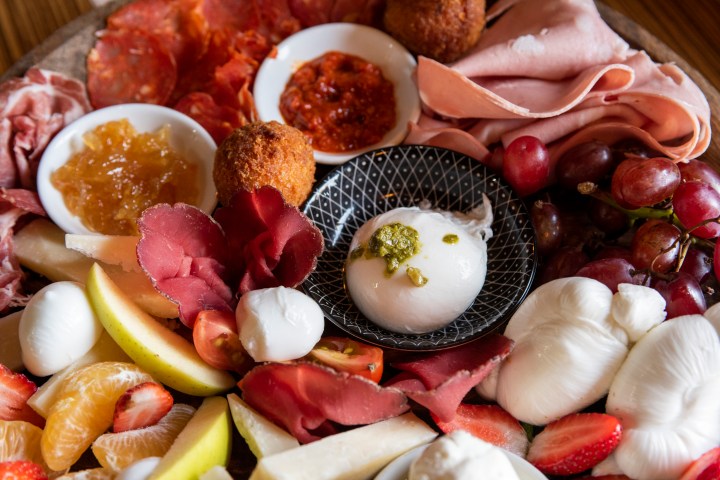
For the pioneers of authentic Italian artisan mozzarella and burrata in South Africa, Puglia Cheese, it’s been a roller coaster ride, as owner Davide Ostuni recounts.
If you’ve ever wondered why Italians speak of cooking mozzarella rather than making it, a glimpse through the window at Puglia Cheese’s artisan factory reveals all. Steam rises as the cheesemaker pours boiling water over a vast bowl of curds, muscles flex as he stirs with a big gondola-style paddle until the curds melt together and become stringy, stretching and stirring, back and forth, dipping hands into a bowl of cold water in between to withstand the heat.
The window is set behind the counter and wood-fired pizza oven at Puglia Cheese’s Osteria Cheese Bar, which together with the cheese factory is a little outpost of Italy on Waterkloof wine estate, just above Somerset West. Eye-stretching views over False Bay to Cape Point from the terrace insist on the South African setting, but otherwise we could be in southern Italy: an unpretentious family osteria, wooden beams, brick walls, a chill room stocked with salamis and ageing cheeses, shelves crammed with wines, pastas and the obligatory Maina panettone.
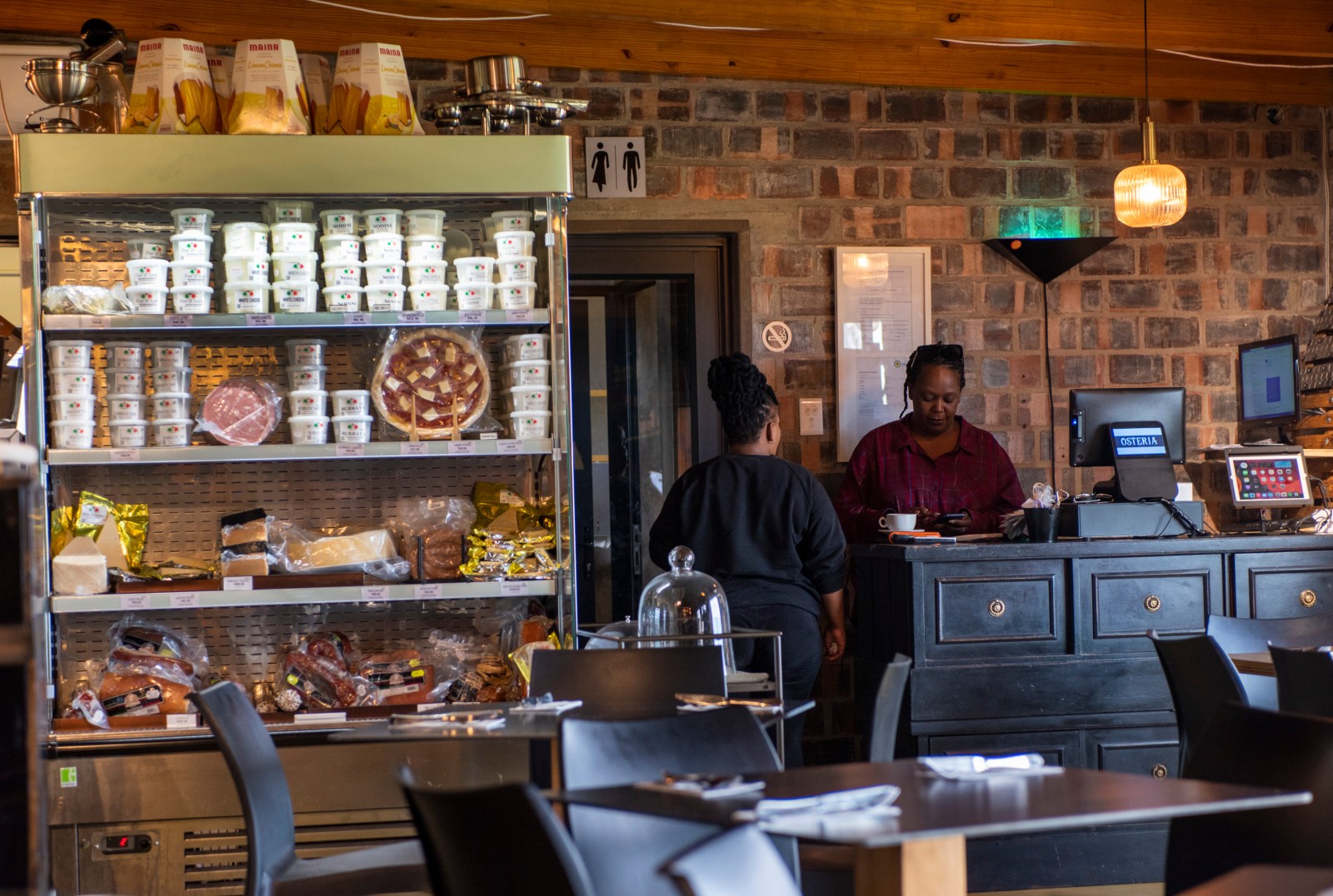
Deli-icious – an array of fresh Puglia cheeses, par-baked pizzas to finish off at home, and imported Italian mortadellas, salamis and hams. (Photo: Patrick Heathcock)
There’s a display fridge stacked with every conceivable variety of fresh mozzarella to my right. Nodini, burrata, stracciatella, bocconcini, fior di latte… these are names and styles of mozzarella cheese that until recently here in South Africa we didn’t know existed. That South African foodies are now blithely able to be on first-name terms with them is down to one man, Davide Ostuni, who I’m waiting to meet.
Due to some crossed wires he’s late and I’m hypnotised by the rhythm and progression of the cheesemaking show in the meantime. This batch of mozzarella is near completion. The cheesemaker expertly manipulates the melting mass with the broad side of the paddle until the strings morph into a silky-smooth elastic sheet, folding and stretching. The movements at this stage are similar to the working of bread dough – dough being the word used to describe this stage of mozzarella too, as I discover later.
Davide and his South African wife Ursula arrive together in a flurry. At a tiled table in the corner Davide settles in for the long run to tell the story – a natural raconteur, starting from when he leaves his home in Brindisi (a coastal town in Puglia, on the heel of southern Italy) at the age of 16. First travelling around Europe, working in France, Spain, Holland until he reached London, at 17, he became the youngest head waiter to date at the Waldorf Astoria.
“I was underage, I wasn’t allowed to serve the wine – someone had to open the bottles for me,” he recalls. But it was a holiday in South Africa several years later that planted the seed that would eventually become Puglia Cheese. That and meeting Ursula here on his second visit in 1994.
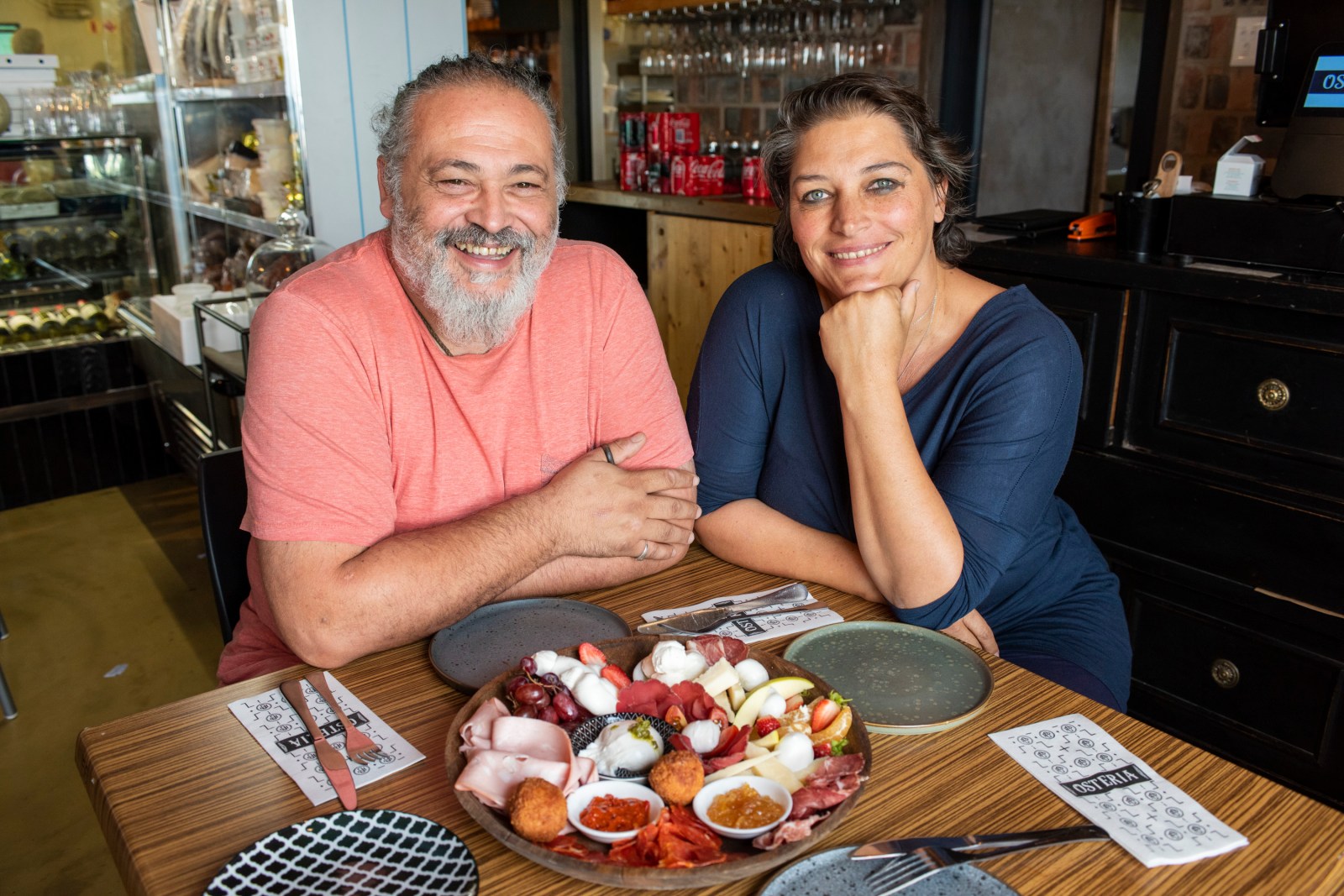
Davide and Ursula Ostuni at a table in Osteria Cheese Bar: “This is what a cheese platter should be,” Davide says. (Photo: Patrick Heathcock)
Their romance is a tale of many visas.
“I’d been running a fashion import business in Cape Town and was about to buy a restaurant, so I thought let me sort my visa out,” Davide says. “My visa said I was a manager of a koi fish shop… I didn’t even know what a koi fish was. When I tried to renew it, I was given 48 hours to leave the country. So I went back to Italy to say hi to my mum and family, thinking I’d sort the visa and come straight back… I’d met my future wife only a few months before. Because of the stamp of leaving within 48 hours it wasn’t easy to come back. Summer was coming in Italy, so I said to Ursula, why don’t you come to Italy?”
“He makes it sound so unromantic,” Ursula says. “I’d just met him four months earlier and when he couldn’t stay in the country, two weeks later he sent me a ticket to join him in Italy.” A long (romantic) summer in Italy was followed by a slow train trip via Rome, Florence and Paris to London where a friend of Davide’s had a restaurant he wanted him to run.
In London it was Ursula’s turn to have problems with her South African passport. “I was deported three times. At this point I can tell you we did not get married for love,” she says, laughing.
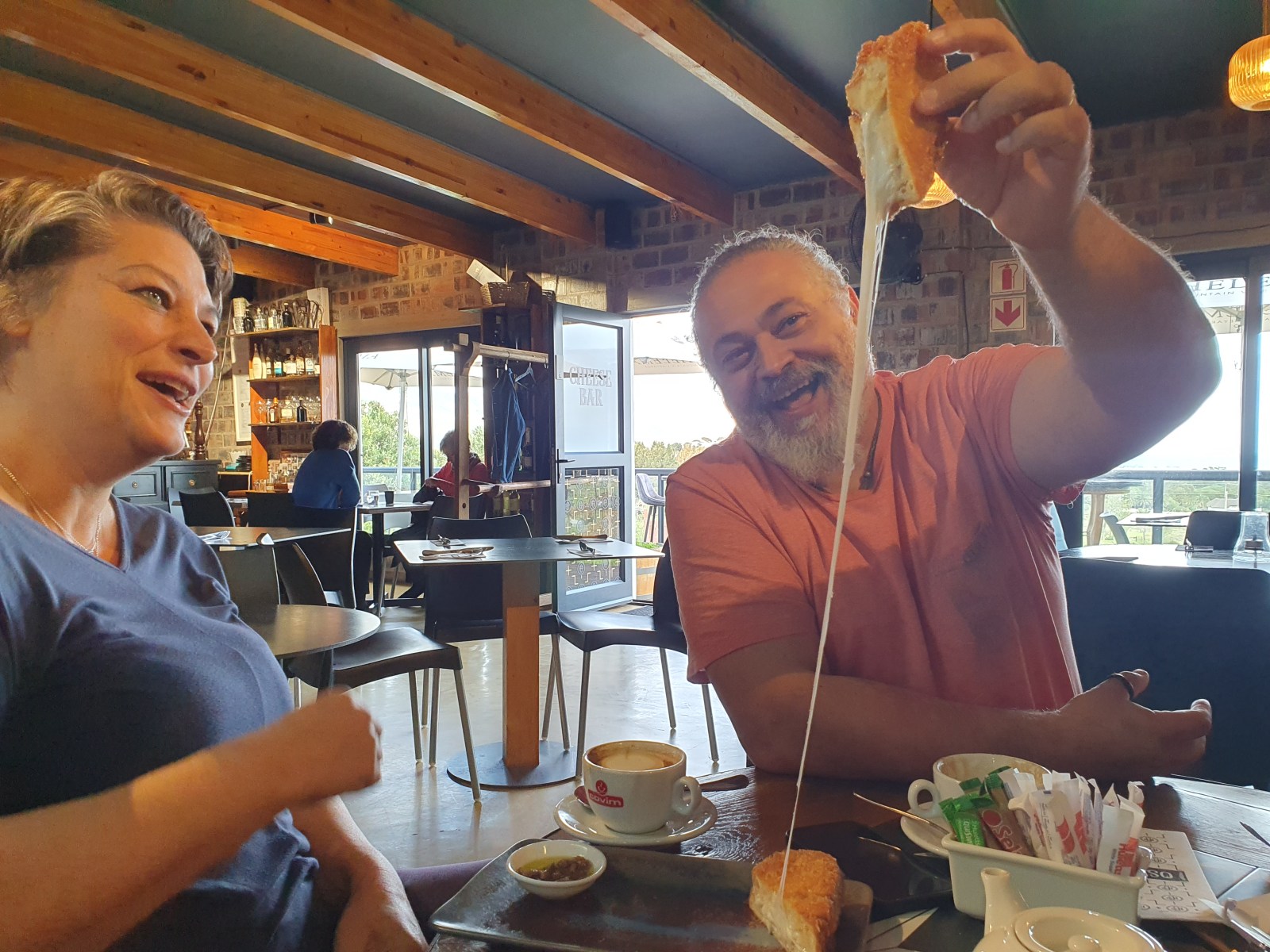
The golden ‘mozzarella in carrozza’ fried sandwich oozes melted fior di latte mozzarella from its carriage of home-made ciabatta coated in breadcrumbs and deep fried. (Photo: Kit Heathcock)
A waitress brings a crispy golden mozzarella in carrozza to the table for Ursula. Davide demonstrates the durability of married bliss by appropriating one half, his excuse being to demonstrate the stretchiness of the melted mozzarella oozing seductively from between the ciabatta sandwich “carrozza”. Cheekily he takes a big bite for quality control purposes, before Ursula can reclaim her breakfast.
The story takes many turns before we reach South Africa and the birth of Puglia Cheese. London was home for many years, owning restaurants, importing Italian foods, until they had kids and wanted to escape the city life. If it wasn’t for a twist of fate, they might be running an agriturismo B&B in a farmhouse outside Brindisi, and South Africa might well still be in the dark about the bliss of burrata. But when, after two years living in Italy, they’d finally found the right place and agreed the sale, the seller of the farmhouse broke his leg, ended up in a hospital bed next to someone who had a German cash buyer looking for property, and sold to him instead. They returned to London. A fortuitous holiday to Cape Town for Christmas 2009 led to a snap decision, this was to be their new home. It was just a question of deciding how to earn a living here.
“I didn’t want to go back into restaurants because of the unsocial hours,” Davide says. “Then this Italian friend said to me I haven’t seen fior di latte mozzarella or burrata here…” He rustled up another Italian friend, who was an experienced cheese master, brought him over to train them and that was it.
“It was ‘let’s see what happens’. I got a place in Montague Gardens, we bought some machinery which we still have, and in June 2010 we opened a cheese factory. I bought the first milk from an Italian here who found me raw milk, and we cooked the first cheese starting with a 50l pot.”
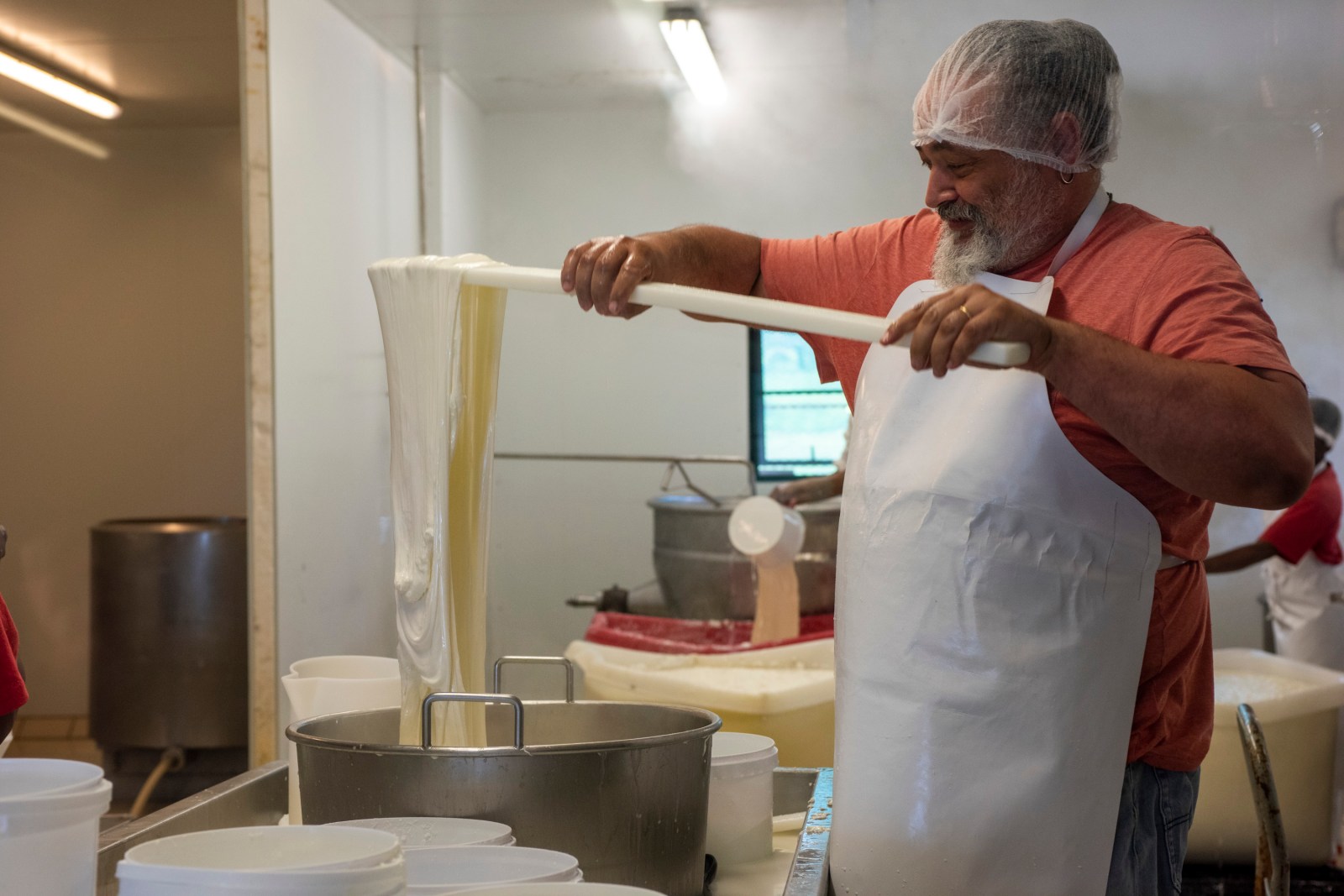
Davide Ostuni manipulates the melting mozzarella dough until it’s smooth, silky and elastic (Photo: Patrick Heathcock)
They tested out their first product on Ursula’s family, who loved it, then headed with their product to Cape Town’s markets.
“Our obstacle now was the people. They were not ready for our cheese – even professed cheese gurus were saying, ‘why are they in water?’ They didn’t know what burrata was. South Africans were used to blocks of mozzarella, basically just cheese for melting… you needed a sticker to tell it’s not Gouda or Cheddar. Our mozzarella is softer, not as powerful in flavour – it’s creamy, it’s the taste of milk, people weren’t used to it.
“But whenever we met Italians they went crazy. Especially one restaurant owner, Giorgio Nava. He made many phone calls with other chefs telling them, guys try this mozzarella, this is the real thing. He became our ambassador.”
Giorgio Nava backed up his belief in their product by opening South Africa’s first mozzarella bar on Kloof Street in 2011. Other top chefs made space on their menus, leading the first wave of a burrata revolution.
“At the Old Biscuit Mill market, chefs like Luke Dale Roberts and David Higgs used to come and get burrata. Then it exploded. These very qualified chefs started experimenting with our products.”
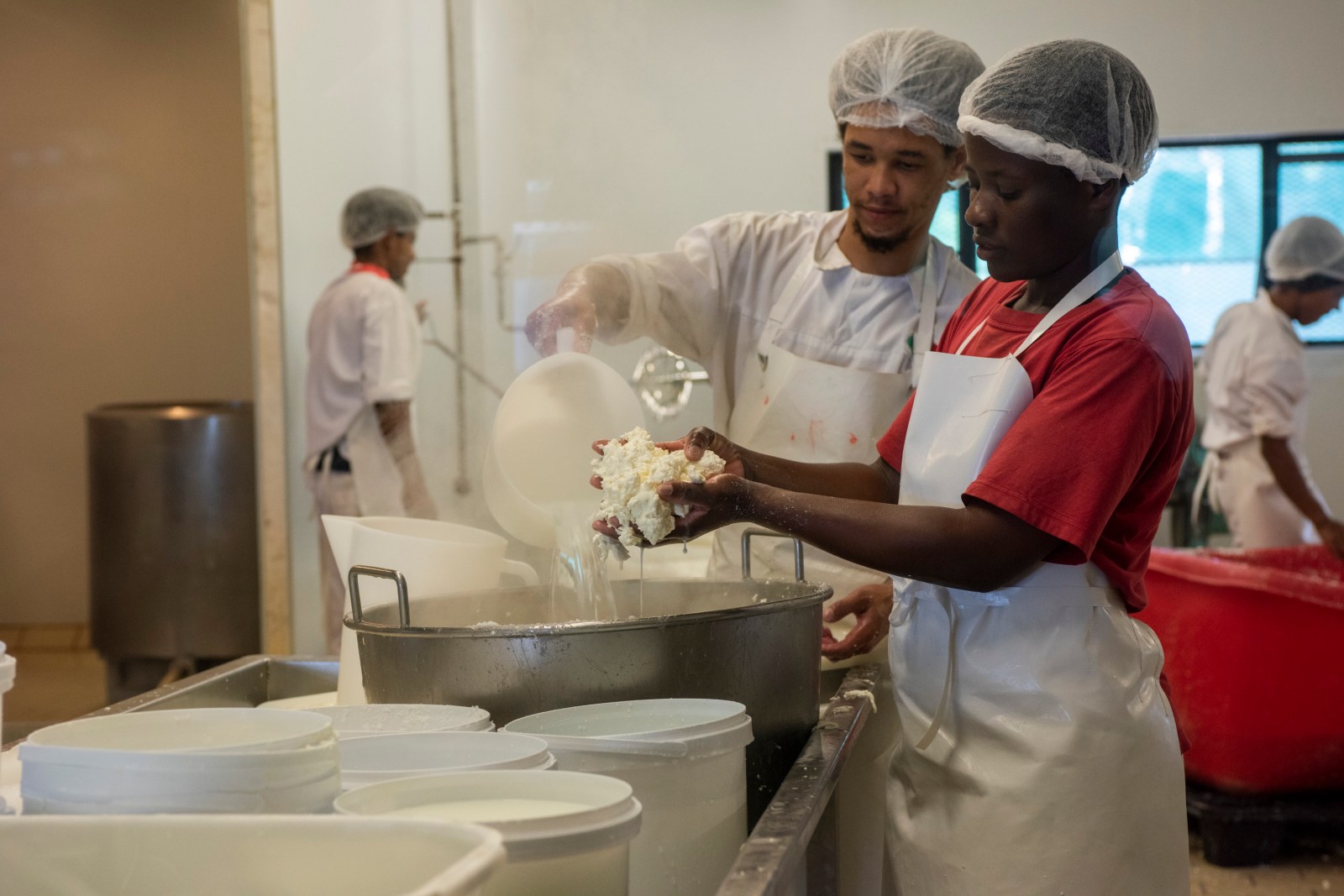
Mozzarella making starts with the curds and a big jug of boiling water to ‘cook’ the mozzarella. (Photo: Patrick Heathcock)
It wasn’t all plain sailing. Some things got lost in translation.
“In South Africa they used to call fresh mozzarella ‘buffalo-style’. In Italian mozzarella di bufala is mozzarella made from buffalo milk. So people were asking me, is this buffalo mozzarella? And I’d say no. Then they wouldn’t buy it. There was confusion about what is a buffalo mozzarella and what is fior di latte. Buffalo mozzarella is made with buffalo milk, fior di latte is made with cow’s milk. One isn’t better than the other, it depends what you like and what you want to use it for.
“At one market I told a woman that buffalo mozzarella is made with buffalo milk and fior di latte with cow’s milk, the word mozzarella is generic. She looked at me and said, ‘Nonsense, I’ve been in Italy, you can’t fool me. Everybody knows that buffalo mozzarella is made from the milk of cows feeding on buffalo grass…’ Whooa, I didn’t even know there was such a thing as buffalo grass.
“I realised we had to bring this barrier down. Restaurants were putting ‘Puglia buffalo mozzarella’ on their menu – because people believed that was the best-quality mozzarella. I insisted on writing on my tubs fior di latte, and now everyone knows it. Everyone’s an expert now.”
Fior di latte translates as flower of the milk – its flavour is completely dependent on the quality of the milk used.
As word spread and Davide increased production, another problem arose.
“Sourcing milk was a nightmare. In South Africa the politics among the big buyers mean that large companies make the farmers sign exclusive rights. Every farmer has that contract, otherwise they can’t sell their milk. All the small farms have closed. It was hard to find independent farmers.”
And the approach to dairy in South Africa is different to Italy, where mozzarella is a daily essential. “When you make cheese like this you have to use the best milk. In Italy farmers have a schedule that tells them how to feed the cows to produce milk suitable for mozzarella. Milk is readily available and if it’s not good the cheesemakers will buy from someone else. But here you have to thank God you have milk. We can’t influence the farmers in how they feed their cows.”
It turns out grass-fed isn’t necessarily best when it comes to milk. Wild grasses and other herbs might give the milk bitterness or give the cow colic. The milk is affected by how the cow feels. Changes of season and temperatures oscillating between hot and cold can upset things.
“The food is too wet, they get too much water. Too much grass makes the milk yellow and too strong in smell. Lucerne is good for them but in a very small quantity. And if they break into a cauliflower field…,” Davide says. And then there’s the science of the protein levels and pH balance in the milk affecting how hard or soft the mozzarella is. “We are like pioneers in this country. It took us five years to make the burrata like it is now.”
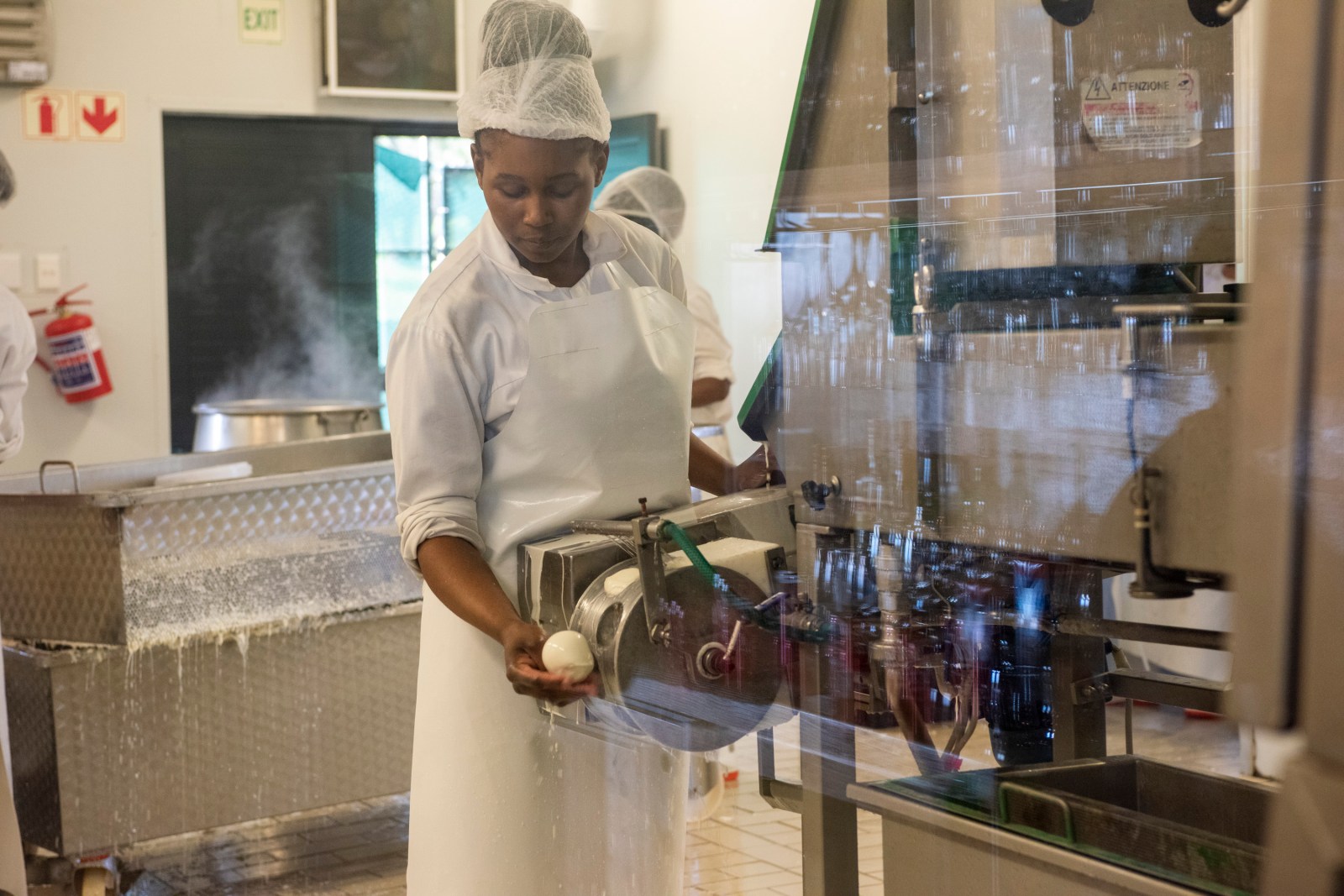
One small part of the process is now mechanised – forming the fior di latte into balls before it’s cooled in iced water. (Photo: Patrick Heathcock)
By 2015 things were going swimmingly and Puglia Cheese finally had the capacity to supply Pick n Pay (the Ackerman family are big fans, and Davide regularly gives mozzarella-making demonstrations at their events). But then it all came crashing down.
“There was a period of about a year when we were in partnership with someone else, but it became so toxic that we had to dismantle everything. We almost didn’t carry on,” Davide says.
He hung on to the Puglia Cheese name and some machinery and started over in a garage, cooking up 20l of milk at a time for a few loyal clients paying cash. “We had to pay cash for milk every day. I got up at 4am to fetch the milk. Then when I’d made the cheese I went to work as a chef in a friend’s restaurant till 11pm. For nine months this went on. Slowly we started growing again.”
If it’s starting to sound like a roller coaster ride, hold onto your hats. Things were back on track and they were just starting renovations to the factory to be able to expand production when the calendar page turned to March 2020.
“Boom, Covid came. We lost 80% of our clients in one day.” After the initial hard lockdown phase, he realised that the only ones operating were the pizza takeaways. “My mozzarella for pizza hadn’t sold well because it was more expensive than block mozzarella. When I realised that was my only channel, I started going to all the pizza shops. ‘Listen, try my mozzarella and you will see that you need 20% less to have the same spread… but you’ll have a better flavour, so at the end of the day it will cost maybe R2 more.’ That’s what saved us.”
It quickly grew into a pizzeria consultation offering. Davide would show them the secrets of the perfect puffy crust of the traditional Neapolitan-style pizza and supply them with his fresh pizza mozzarella, imported Caputo pizza flour and tomatoes. If you cast your mind back to the sudden improvement in Cape Town’s pizza scene from late 2020 into 2021 you are likely to detect the distinctive fresh, milky flavour of Puglia mozzarella as the secret ingredient.
“All the pizza shops started buying from us – they’d tasted the difference in the pizza places we’d helped and wanted the same mozzarella for theirs.”
We’re back at the window looking into the factory now, watching as cooked mozzarella is rolled and stuffed into cylindrical sleeves for the pizzerias; they call it Biancaneve fior di latte, it has slightly lower water content designed to withstand the heat of wood-burning ovens.
Capped and aproned behind the scenes now, Davide works the next batch of mozzarella to the fineness needed for their signature burrata.
“How hot the water is determines which mozzarella we make,” Ursula explains. “For burrata the mozzarella has to be super soft, and you only get that with really hot water.”
It starts with the same curds and technique as regular fior di latte but uses a second round of 95-degree water, to become softer and more elastic, able to be stretched into thin sheets, the texture needed to hold the luscious stracciatella filling of ripped mozzarella mixed with double cream.
When they moved their production to Waterkloof wine estate in August 2022, besides plentiful fresh mountain water, and the space they needed to expand, the new premises had a front section previously used as a deli. This spurred the idea of opening a cheese bar to showcase how to use the different cheeses in a variety of dishes. We might now be experts on burrata, but there’s still a way to go before South Africans plumb the full possibilities of these fresh Italian cheeses. Ricotta gnocchi, mascarpone and lamb ravioli, mozzarella in carrozza, or a show-stopping burrata Benedict (filled with an egg yolk, guanciale and spinach and wrapped in phyllo pastry, are a few things on the mouth-watering menu. Plus of course their puffy crusted sourdough pizzas crowned with the fior di latte. It’s proved a hit with Somerset West locals. On a Friday at lunchtime every table is full and it’s booked up for dinner.
And there’s good news for Gauteng too. Davide is just back from opening a new production facility in Pretoria, the solution to what was becoming a logistics nightmare: shipping such a fresh product up to their Gauteng customers without spoilage.
“My mozzarella is very sensitive, it goes into thermic shock if the cold chain is broken. It’s not like those mozzarella blocks that you can squeeze the hell out of, or even play tennis with,” he says. And Joburg is next on the list with a new production and deli space planned there for later in the year.
Once you’ve tasted Puglia cheese’s burrata there’s no going back. But you can continue the journey by exploring the ever-increasing range of cheeses they now produce – smoked scamorza, ricotta, salted ricotta, caciocavallo; all of which are a true taste of Italy, inscribing that wild coastal region at the heel of Italy into the foodie map of South Africa. DM/TGIFood
Find out more about Puglia Cheese www.puglia.co.za/
Follow Kit Heathcock on Instagram @kitheathcock
The writer supports SA Harvest who address food waste by rescuing nutritious surplus food from farmers, manufacturers and retailers, and delivering it to the organisations who feed the hungry around South Africa https://saharvest.org/





Thank you for this wonderful article, can’t wait for Puglia Cheese to get to Joburg!
So enjoyed and appreciated this story. Such an interesting and well-written read. Thanks.